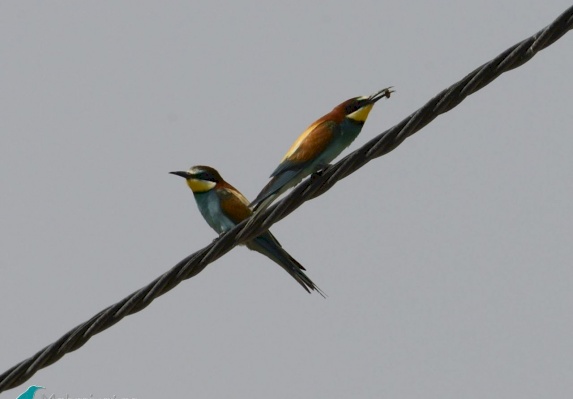European Bee-eater
© All rights reserved by www.mahmiyat.ps
|
The European Bee-eater belongs to the Meropidae family in the Corachformes order.It is 25-29 cm in size and 38-68 grams in weight. The Bee-eater is a strikingly beautiful bird with a variety of colors. The cap and the back of the head are red-rustic colored and the back is yellow-orange and the combination looks like a flame. The chest and abdomen are turquoise-blue, the fore-head is white, and the throat and cheeks are yellow, the eye is blood-red and covered by a black stripe. The wings are a combination of brown, green, black, yellow and orange. The feathers of the Bee-eaters have a large quantity of microscopic prisms that break up the sunlight into light waves of different lengths forming many metallic hues that change with shifting light angles. The Bee-eater is a very social bird, migrating in flocks and nesting in large colonies. This is one of the few birds that migrate both day and night. The Bee-eater is considered a pest because it feeds mainly on bees, however it also targets wasps which damage bee hives so that balances out their damage. The Bee-eater also preys on carpenter bees, ants, dragonflies, butterflies, moths, and flying termites. The prey is usually caught while hovering and maneuvering in the air in all directions. It is also known to attack from a view point, catching the prey in the air or on the ground. Small prey is swallowed in the air while larger prey is brought to a "dining table" where it is eaten after the stinger is neutralized. The Bee-eater is known to be a very capable predator with an extremely high success rate. The migrating flocks call very loudly and can be heard from afar. The breeding population arrives to this area during the end of March—beginning of April. The couple builds a nest in an earthen wall that in the shape of a horizontal tunnel that can be 2 meters in length and can take two weeks to complete (10-30 cm/day). At the end of the tunnel a "breeding chamber" is dug of 20 cm diameter. The couple sleeps there and regurgitates pellets with the remains of insects such as wings and legs. On this accumulation 4-7 eggs are laid. The eggs are incubated for 20 days and the nestlings hatch asynchronously during several days. The European Bee-eater is the only family member who is found in Europe, from Spain through the central and south Europe, Mediterranean area, the Middle East and central Asia. These populations have a long- migration route and winter in central Africa. Another population is stable in South Africa. The population is decreasing due to sportive hunting, development in their preferred habitats and breeding areas, and through aggressive actions of bee-keepers and farmers. International conservation status: LC, Regional conservation status: LC Migratory behaviour: Breeder
|

